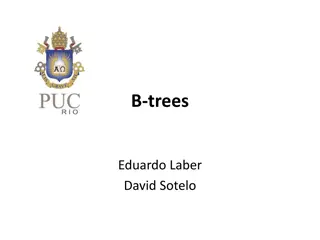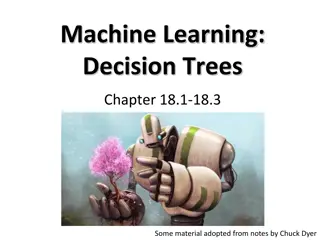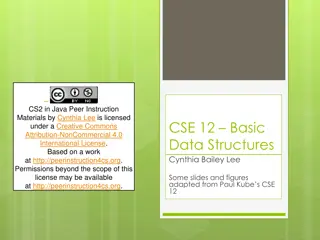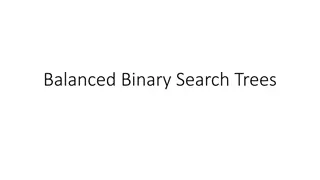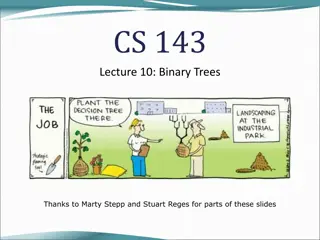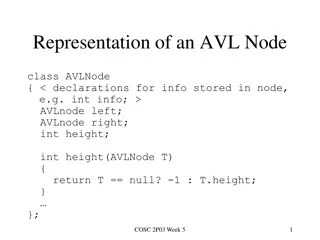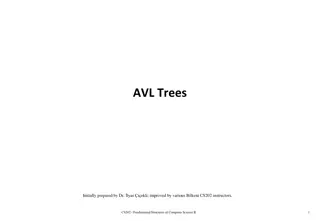Understanding Binary Codes and Their Applications
Binary coding is crucial for digital systems as they understand only 0s and 1s. This process converts information into binary language for processing by digital circuits. Different types of binary codes like weighted codes and BCD codes are used for error correction, digital communication, and compu
7 views • 20 slides
Monumental Trees of Italy - A Natural Legacy of Grandeur and Cultural Significance
Italy boasts a rich heritage of monumental trees, defying the challenges of nature and human exploitation to grow into majestic and culturally significant specimens. These grand trees symbolize the enduring bond between nature and humanity, embodying naturalistic, aesthetic, and historical values. T
7 views • 23 slides
Understanding Binary Counters and Types of Counters
Binary counters are registers used to count clock pulses, while binary counters follow the binary number sequence. There are two types of counters: serial/asynchronous counters and parallel/synchronous counters. Serial counters change output flip-flop to next flip-flop, requiring minimal hardware bu
12 views • 21 slides
Understanding Binary Number System and its Applications
Explore the world of binary numbers with insights on what binary is, its significance in computing, conversion methods between binary and decimal, hexadecimal number system, and binary arithmetic operations. Dive into the foundations of digital communication through the language of zeros and ones.
0 views • 24 slides
Understanding B-Trees: Efficient Data Storage and Retrieval
B-Trees are balanced search trees designed for secondary storage devices, commonly used by databases. They can have many children, allowing for efficient data organization. The branching factor of B-Trees keeps their height low, making them ideal for minimizing disk I/O operations. This article expl
1 views • 76 slides
Understanding AVL Trees: A Self-balancing Binary Search Tree
AVL trees, named after their inventors Adelson-Velski & Landis, are self-balancing binary search trees where the height difference between left and right subtrees is limited. This ensures a balanced factor of -1, 0, or 1, leading to efficient operations such as insertion and deletion. Rotation techn
2 views • 21 slides
Understanding Decision Trees in Machine Learning
Decision trees are a popular supervised learning method used for classification and regression tasks. They involve learning a model from training data to predict a value based on other attributes. Decision trees provide a simple and interpretable model that can be visualized and applied effectively.
1 views • 38 slides
Exploring Trees Data Structures Using C - Second Edition
Learn about trees data structures in the context of programming using the C language. This comprehensive guide covers topics such as types of trees, tree creation, traversal, basic terminologies, and different tree structures like binary trees and binary search trees. Dive into the world of trees da
2 views • 54 slides
Understanding Binary Code and Color Conversion
Delve into the fascinating world of binary code and learn how it works to represent data digitally. Discover the process of decoding binary pulses into colored pixels, using binary sequences to identify colors, and practicing digital-analog conversion through logic maps. Explore the language of bina
0 views • 20 slides
Understanding Heaps in Binary Trees
Heaps are binary trees that adhere to specific properties, such as being complete and satisfying the heap-order property. This involves nodes having keys smaller than or equal to their children. Key operations like removeMin and insert can be performed on heaps efficiently. Array implementations all
0 views • 10 slides
Understanding Decision Trees in Machine Learning with AIMA and WEKA
Decision trees are an essential concept in machine learning, enabling efficient data classification. The provided content discusses decision trees in the context of the AIMA and WEKA libraries, showcasing how to build and train decision tree models using Python. Through a dataset from the UCI Machin
3 views • 19 slides
Understanding Binary Heaps: Efficient Data Structure for Priority Queue Operations
Explore the concept of binary heaps, a specialized type of binary tree that allows for quick retrieval of the smallest (or largest) element. Learn how binary heaps excel in finding the minimum value, essential for priority queue applications in operating systems, event simulations, and more. Compare
2 views • 34 slides
Understanding Trees and Binary Trees in Data Structures
A tree in data structures is a finite set of nodes with a designated root and subtrees, including internal nodes and leaf nodes. Terminology like root, parent nodes, leaves, and levels are explained, along with concepts of height and degree of a tree. Additionally, binary trees are introduced as a s
1 views • 94 slides
Understanding Binary Logic Systems in Documentation
Binary logic systems play a crucial role in documentation for individuals with diverse backgrounds such as management, process designers, operations staff, maintenance technicians, and more. These systems, depicted in binary logic diagrams, provide a clear and concise representation for various prof
4 views • 16 slides
Understanding Binary Search Trees and Tree Traversal Methods
Explore the world of binary search trees with a focus on defining trees, modifying them, and different ways to print their contents. Delve into the concept of tree traversal methods such as pre-order, in-order, and post-order. Additionally, discover insights into searching algorithms for arrays of n
0 views • 14 slides
Understanding AVL and B-Trees in CSE 332 Autumn 2023
AVL trees are self-balancing binary search trees that ensure the heights of left and right subtrees differ by at most one, maintaining balance during insertions and deletions through rotations. This lecture delves into AVL trees, their implementation, balancing techniques, and examples, along with i
0 views • 35 slides
Understanding Priority Queues and Heaps in CSE 373 Lecture
Today's lecture in CSE 373 covers the Priority Queue Abstract Data Type (ADT), the properties of heaps, and their implementations. Key topics include the completeness property of heaps, different priority queue implementations such as the binary search tree for faster insert and find operations, and
0 views • 21 slides
Binary Trees and Heap Implementation in Java
Explore the concepts of binary trees, heap implementation, and traversal techniques in Java through engaging peer instruction materials by Cynthia Lee. Learn about heap uniqueness, in-place heapsort, and generic binary trees. Test your knowledge with reading quizzes and analyze heap outcomes based o
0 views • 27 slides
Exploring the Binary Number System in Mathematics
Delve into the intricacies of the binary number system with this comprehensive guide. Learn how binary numbers are formed, and master the conversion techniques between binary and decimal numbers. Discover the fascinating world of binary fractions and the algorithms for converting decimal numbers to
0 views • 20 slides
Understanding Red-Black Trees for Balanced Search Structures
Red-black trees are balanced binary search trees ensuring a maximum height of O(log n). They maintain balance properties by coloring nodes red or black, with operations such as search, insertion, deletion efficiently managed in O(log n) time. Red-black trees exhibit guaranteed height bounds for impr
0 views • 26 slides
Understanding Height-Balanced Binary Trees and AVL Trees
The efficiency of tree operations like searching, insertion, and deletion is closely tied to the tree's height. Maintaining a balanced height in trees, such as AVL trees, ensures O(log2n) complexity for efficient operations. Learn about height-balanced binary trees, how to check if a tree is balance
0 views • 27 slides
Understanding Balanced Search Trees and Red-Black Trees
Balanced Search Trees ensure efficient data retrieval by maintaining balancedness properties within the tree structure. Red-Black Trees are a type of binary search tree with specific coloring rules that help in balancing and efficient searching. Learn about the structure, properties, and worst-case
0 views • 75 slides
Understanding Spanning Trees and Minimum Spanning Trees
Explore the concept of spanning trees and minimum spanning trees in graph theory through an in-depth lecture outline covering topics like Cut Property, Cycle Property, Kruskal's Algorithm, and more. Delve into the significance of Minimum Spanning Trees (MSTs) as the lowest-cost spanning tree of a gr
0 views • 41 slides
Introduction to Binary Arithmetic for Digital Electronics
Binary arithmetic is fundamental in digital electronics, involving addition, subtraction, and multiplication of binary numbers. This guide explains the rules and examples of binary arithmetic operations, such as binary addition and subtraction, along with detailed steps and illustrations for better
0 views • 21 slides
Understanding Trees and Optimality Criteria
In this lecture, you will delve into the world of trees and optimality criteria. Explore concepts like external and internal branches, terminal nodes, and vertices. Discover the Newick format for tree representation, the rooting of trees, and free rotations around nodes. Dive into the growth of tree
0 views • 15 slides
Solving the Apple Tree and Conifer Tree Pattern Puzzle
In this mathematics unit, we explore a scenario where a farmer plants trees in a square pattern, with conifer trees surrounding the apple trees for protection against the wind. The task involves completing a table to understand the pattern for different numbers of rows of apple trees. Through this e
0 views • 15 slides
Understanding Binary Codes and Character Coding Techniques
Binary codes, such as ASCII and EBCDIC, are crucial in representing data in computers and digital systems. They play a key role in error detection and data encoding. This article discusses the basics of binary coding, various types of binary codes, character coding techniques like ASCII and EBCDIC,
0 views • 22 slides
Implementation of Red-Black Trees in 2-3 Trees
Implementation of Red-Black Trees within the structure of 2-3 Trees involves representing 3-nodes using red links, maintaining specific restrictions on representation, ensuring perfect black balance, and establishing a correspondence between red-black BSTs and 2-3 trees. Observations include the col
1 views • 8 slides
Automating Separation Logic with Trees and Data
This content discusses the automation of separation logic using trees and data, focusing on extracting the maximum element in a Binary Search Tree (BST). It covers the motivation behind the procedure for extracting the max element, memory safety considerations, functional correctness, and preserving
0 views • 38 slides
Understanding Binary Trees in Computer Science
Binary trees are a fundamental data structure in computer science with various applications. This content covers the basics of binary trees, including terminology, recursive definitions, node structures, and implementations in computer science. It touches on important concepts such as recursion, tre
0 views • 28 slides
All About Sumac Trees: Features, Uses, and Care Tips
Sumac trees, known for their shrubs and small trees with clusters of reddish drupes, are commonly found in North America and Africa. These trees, comprising approximately 250 species, are used for landscaping but some species can cause skin irritation. With minimal care requirements, sumac trees can
0 views • 11 slides
Understanding Classification and Regression Trees
Classification and Regression Trees are powerful tools used in data analysis to predict outcomes based on input variables. They are versatile, easy to interpret, and can handle both categorical and continuous predictors. Different types of trees, such as Regression Trees, Boosted Trees, and Random F
0 views • 16 slides
Understanding Binary Representation of Numbers with Fractions
Learn how to represent numbers with fractions in binary form. Discover the process of converting real numbers, like 5.75, into binary by separating the integer and fraction parts. Explore the method of obtaining the binary representation of the fraction through division by specific decimal values. U
0 views • 21 slides
Understanding Unrooted Trees in Phylogenetics
Explore the concept of unrooted trees in phylogenetics, including Newick strings, induced quartet trees, and representations. Learn about the importance of drawing rooted and unrooted trees, as well as understanding the relationship between unrooted trees and binary rooted evolutionary trees.
0 views • 63 slides
Understanding Trees in Discrete Structures
Discrete Structures and Their Applications Trees Chapter discusses the properties and theorems related to trees in graph theory. Trees are defined as connected, undirected graphs with no cycles. The content covers the characteristics of leaves, internal vertices, and the relationship between the num
2 views • 28 slides
Data Structure Concepts: AVL Trees and B-Trees
The content covers important concepts related to AVL trees and B-trees, including the representation of an AVL node, insertion operations, rotations for balancing, and definitions of B-trees. AVL trees are self-balancing binary search trees used to maintain balance during insertions and deletions, w
0 views • 14 slides
Understanding AVL Trees in Data Structures
AVL trees are self-balancing binary search trees that help maintain efficiency in operations by ensuring the tree remains balanced. By enforcing a balance condition, AVL trees aim to keep the depth of the tree logarithmic, leading to O(log n) complexity for operations such as find, insert, and delet
0 views • 39 slides
Understanding AVL Trees: Balanced Search Trees for Efficient Operations
AVL Trees are balanced search trees that ensure efficient insertion, deletion, and retrieval operations with a worst-case time complexity of O(log N). Named after their inventors Adelson-Velskii and Landis, AVL Trees maintain balance by limiting the height difference between left and right subtrees
0 views • 28 slides
Understanding Binary Trees in Java
Binary trees are a fundamental data structure in Java composed of nodes with values and references to left and right children. Nodes have specific relationships like parent-child, ancestor-descendant, and sibling. The size and depth of a binary tree determine its structure, and balancing is essentia
0 views • 19 slides
Understanding Binary Numbers and Computer Data Representation
A computer stores information digitally as binary numbers, where data is broken down into pieces and represented as numbers. The binary system uses 0s and 1s to encode information, with each bit representing on/off states. This system is crucial for converting data into machine language. Binary numb
0 views • 14 slides




